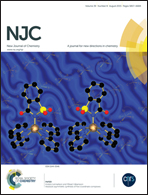Carbon nanotube/S–N–C nanohybrids as high performance bifunctional electrocatalysts for both oxygen reduction and evolution reactions†
Abstract
Exploring high performance bifunctional electrocatalysts for efficient oxygen reduction and evolution reactions is of crucial importance for sustainable energy conversion and storage devices including rechargeable metal–air batteries and fuel cells. In this work, one-dimensional (1D) cable-like multiwall carbon nanotube/S, N co-doped carbon nanodot (MWCNT@S–N–C) hybrids were synthesized by annealing multiwall carbon nanotubes/polythiophene (MWCNT@Pth) in the NH3 atmosphere. The as-prepared catalysts exhibit an outstanding oxygen reduction reaction (ORR) activity (an unusual high limiting current density of 7.62 mA cm−2), strong immunity towards methanol crossover and long-term stability. Moreover, the obtained catalysts also display a higher activity toward oxygen evolution reaction (OER) compared to the state-of-the-art IrO2 catalyst, demonstrating excellent overall bi-catalytic performance. This superior electrocatalytic activity arises from synergistic chemical coupling effects between S and N, excellent reactant transport provided by mesoporous structures and a high charge transfer rate driven by 1D MWCNTs, thereby generating a high performance bi-functional electrocatalyst for both ORR and OER. This is the first time that S, N co-doped carbon materials have been investigated as effective bifunctional catalysts, which not only provides a further insight into the electrocatalytic mechanism, but also provides a new approach for the design and fabrication of metal-free bi-functional oxygen catalysts with low cost and high efficiencies in electrochemical energy conversion.


 Please wait while we load your content...
Please wait while we load your content...